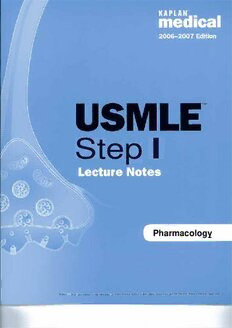
Kaplan USMLE Step 1 Lecture Notes 2006-2007: Pharmacology PDF
Preview Kaplan USMLE Step 1 Lecture Notes 2006-2007: Pharmacology
Step I Pharmacology 'WSMU~ isa~aintprogram 0~thelfederatla°n a"• State Meaieal Boaras a~the I!JntiteaStates•lne,andthe Natianal Baaraa1MediealExaminers. USMLE·Step 1 Pharmacology Lecture Notes 2006-2007 Edition I KAPLA~. meulca •USMLEisajoint programoftheFederationofState Medical Boardsofthe UnitedStates, Inc.andthe National BoardofMedical Examiners. ©2006 Kaplan, Inc. Allrights reserved. No part of this book may be reproduced in any form, byphotostat, microfilm, xerography or any other means, or incorporated into any information retrieval system, electronic or mechanical, without the written permission of Kaplan, Inc. Not for resale. Author Lionel P.Rayman, Pharm.D., Ph.D. Department ofPathology Forensic Toxicology Laboratory University ofMiami School ofMedicine Miami, FL Contributing Authors Director of Medical Curriculum Sonia Reichert, M.D. Craig Davis, Ph.D. Associate Professor Editorial Director University ofSouth Carolina School ofMedicine Kathlyn McGreevy Department ofPharmacology, Physiology, and Neuroscience Columbia, SC Production Manager Maris Victor Nora, Pharm.D., Ph.D. Michael Wolff Associate Professor Production Editor Rush Medical College Chicago.Tl. William Ng Anthony Trevor, Ph.D. Cover Design ProfessorEmeritus Joanna Myllo Department ofCellular and Molecular Pharmacology University of California CoverArt San Francisco,CA Christine Schaar Steven R.Harris, Ph.D. Associate Dean for Basic Sciences Associate ProfessorofPharmacology Pikeville CollegeSchool ofOsteopathic Medicine Pikeville, KY Contributor Kenneth H. Ibsen, Ph.D. Director ofAcademic Development Kaplan Medical ProfessorEmeritus Biochemistry University ofCalifornia-Irvine Irvine, CA • Contents Preface ix Sedion I: General Principles Chapter 1:Pharmacokinetics 3 Chapter 2: Pharmacodynamics 21 Chapter 3: Practice Questions 31 Sedion II:Autonomic Pharmacology Chapter 1:TheAutonomic Nervous System (ANS) 41 Chapter 2: Cholinergic Pharmacology 47 Chapter 3:Adrenergic Pharmacology 57 Chapter 4: Autonomic Drugs: Glaucoma Treatment and ANSPracticeProblems 65 Chapter 5: Autonomic Drug Listand Practice Questions 73 Sedion III:cardiac and Renal Pharmacology Chapter 1:Fundamental Concepts 87 Chapter 2: Antiarrhythmic Drugs 93 Chapter 3: Antihypertensive Drugs 97 Chapter 4: Drugs for Heart Failure 103 ~~~Ica.'·'1''· • lllVU ;:·v -.-------_1 ----==..,.......----""""=== ---"""""-=-.. Chapter 5: Antianginal Drugs 107 Chapter 6: Diuretics ......................... ..... ................ 111 Chapter 7: Antihyperlipidemics ..................................... 117 Chapter 8: Cardiac and Renal Drug list and PracticeQuestions .......... 121 Sedion IV: eNS Pharmacology Chapter 1:Sedative-Hypnotic-Anxiolytic Drugs 133 Chapter 2: Alcohols ........................ 139 Chapter 3: Anticonvulsants 141 Chapter 4: Drugs Used inAnesthesia 145 Chapter 5: Opioid Analgesics 151 Chapter 6: Drugs Used in Parkinson Disease and Psychosis 155 Chapter 7:Drugs Used for Depression, Bipolar Disorders, and Attention DeficitHyperactivity Disorder (ADHD) 161 Chapter 8: Drugs ofAbuse 165 Chapter 9: CNSDrug list and Practice Questions 169 Sedion V.Antimicrobial Agents Chapter 1:Antibacterial Agents 181 Chapter 2: AntifungalAgents 197 Chapter 3:AntiviralAgents 201 Chapter 4: Antiprotoloal Agents 209 Chapter 5: Antimicrobial Drug list and Practice Questions 213 vi m8CIical Sedion VI. Drugs for Inflammatory and Related Disorders Chapter 1:Histamine and Antihistamines 227 Chapter 2: Drugs Usedin Gastrointestinal Dysfunction .•... ;........•.. 229 Chapter 3: Drugs Acting on Serotonergic Systems ................•.... 235 Chapter 4: Eicosanoid Pharmacology ......................•......... 239 Chapter 5: Drugs Usedfor Treatment of Rheumatoid Arthritis 245 Chapter 6: Drugs Usedfor Treatment of Gout............•......••.... 247 Chapter 7: Glucocorticoids ........................•.......•.......• 249 Chapter 8: Drugs Usedfor Treatment of Asthma 251 Chapter 9:list of Drugsfor Inflammatory Disordersand PracticeQuestions... 255 Sedion VII: Drugs Used in Blood Disorders Chapter 1:Anticoagulants 269 Chapter 2: Thrombolytics ......................•........•........•. 273 Chapter 3: Antiplatelet Drugs .........................•............ 275 Chapter 4: list of DrugsUsedin Blood DisordersandPracticeQuestions ..... 277 Sedion VIII: Endocrine Pharmacology Chapter 1:Drugs Usedin Diabetes....................••............ 283 Chapter 2: Steroid Hormones ...............................•...... 287 Chapter 3: Antithyroid Agents........................•...•......... 293 Chapter 4: Drugs Relatedto Hypothalamic and Pituitary Hormones 295 Chapter 5: Drugs Usedfor Bone and Mineral Disorders 297 Chapter 6: Endocrine Drug list and PracticeQuestions ...........•..... 299 2II!n~!naIi'ca'"'." :,V•lI• Sedion IX: Anticancer Drugs . Chapter 1:Anticancer Drugs 307 Chapter 2: Anticancer Drug PracticeQuestions 311 Sedion X: Immunopharmacology Chapter 1:Immunopharmacology 315 Chapter 2: Immunopharmacology PracticeQuestions .................. 317 Sedion XI: Toxicology Chapter 1:Toxicology 321 Chapter 2: Toxicology PracticeQuestions 327 Index " 329 I viii mUP~v~u,;lC8 Preface These seven volumes of Lecture Notes represent a yearlong effort on the part of the Kaplan Medical faculty to update our curriculum to reflect the most-likely-to-be-tested material on the current USMLE Step 1exam. Please note that these are Lecture Notes, not review books. The Notes were designed to be accompanied by faculty lectures-live, on video, or on the web. Reading these Notes without accessing the accompanying lectures is not an effective way to reviewfor the USMLE. To maximize the effectiveness of these Notes, annotate them as you listen to lectures. To facilitate this process, we've created wide, blank margins. While these margins are occasionally punctuated by faculty high-yield "margin notes," they are, for the most part, leftblank for your notations. Many students find that previewing the Notes prior to the lecture is a very effective way to prepare for class. This allows you to anticipate the areas where you'll need to pay particular attention. It also affords you the opportunity to map out how the information is going to be presented and what sorts of study aids (charts, diagrams, etc.) you might want to add. This strategy works regardless of whether you're attending a live lecture or watching one on video or the web. Finally,wewant to hear what you think. What doyou likeabout the notes? What do you think could be improved? Pleaseshare your feedback [email protected]. Thank you forjoining Kaplan Medical, and best ofluck on your Step 1exam! KaplanMedical I mUP~v~u. lC8 ix
